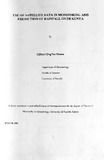| dc.description.abstract | Skillful monitoring, prediction and early warning of the extreme weather events is
crucial in the planning and management of all rain dependent socio-economic activities. They
are also vital for the development of effective disaster preparedness strategies. Prediction
methods depend on availability of long period, high quality data with good spatial coverage.
Real and near real time data are also useful as initial conditions for the integration of
prediction models. Thus, high quality data with good spatial and temporal coverage is
fundamental for any research and applications. Unfortunately, limitation of rainfall data is a
serious problem in many parts of the world, especially in the developing countries.
This study investigated the viability of satellite derived data in providing alternative
rainfall information and hence enhancing rainfall monitoring, prediction and disaster
preparedness in Kenya. The data sets used in the study included observed daily rainfall,
dekadal Cold Cloud Duration (CCD) and pentad Total Precipitable Water (TPW) data
together with the reanalysis data from ECMWF.
The various methods that were used to achieve the objectives of the study included
data quality analyses, S-mode Principal Component Analysis (PCA) together with correlation
and regression analyses. The regression models used included simple linear, stepwise and
canonical regression approaches. The skills of the developed models were further investigated
during anomalous wet and dry periods. Meteorological conditions that could be associated
with the decreased or increased skill of the regression models during the anomalous periods
were also investigated.
The results obtained from the quality control tests indicated that all data used in the
study were of good quality. The S-mode PCA solutions delineated eleven regions for March-
April-May (MAM), June-July-Augu§t (JJA) and December-January-February (DJF) seasons,
while only nine were delineated for the September-October-November (SON) season from the
rainfall data. The number of significant PCA modes was higher for the dry seasons of JJA and
DJF as compared to those from the wet seasons of MAM and SON. However, these
components extracted relatively low percentage of total variance in the observed rainfall and
hence the development of regression models concentrated on the wet seasons of MAM and
SON. Although the duration of the satellite-derived data available was shorter, the regions
derived from this data set were generally consistent with those obtained using the rainfall
data.
The results from correlation analyses showed significant linear relationships between
rain gauge rainfall and only CCD data. The results of ANOV A tests on the linear regression
models indicated that the developed models had reasonable skill in estimating rainfall from
CCD data. Results from stepwise regression analyses of rain gauge rainfall, CCD and the
three layers of TPW data indicated that the additional variance explained by the inclusion of
TPW data were generally low. It was, however, evident that, in some regions, the inclusion of
TPW in the estimation models was of added value. The examinations of the skill of the
models during anomalous dry and wet periods revealed better performance during the
anomalous seasons. The composites of the meteorological conditions showed that for the
anomalous dry seasons, a westerly component exists in the equatorial winds (surface to 800
mb layer) that interferes with the supply of moisture from the Indian Ocean and lead to a
reduction in the amount of moisture available inland. During anomalous wet seasons, the
southeasterly flow inland is very strong enhancing the moisture influx from the Indian Ocean.
. The last part of the study examined the more complex Canonical Correlation Analysis
(CCA) in the development of estimation and forecasting models. The results from the CCA
indicated significant year to year variations in the skills for the estimated areal observed
rainfall from satellite-derived data. !;;.. comparison of the CCA models results to those of the
stepwise regression revealed that the CCA models performed considerably better during the
Vll
SON season in estimating the areal observed rainfall. The results from the forecasting models
revealed that the canonical correlation coefficients based on CCD data were all not
statistically significant in all locations and seasons. Results obtained from analyses of TPW
data, however, indicated some skill in forecasting of rainfall with SON season registering
higher canonical correlation coefficients.
This study has, for the first time, regionalized Kenya into seasonal climatological
homogeneous zones using satellite-derived data. It has also developed statistical models based
on satellite-derived data that can be used to estimate areal rainfall for the derived
climatological zones. The study further highlights the vital need to use distinct CCD
temperature thresholds for rainfall estimation for individual climatological zones and seasons.
Finally, it is the first time that a study has used CCA technique for the estimation of areal
rainfall from satellite-derived data in Kenya. CCA predictors were also derived for areal
rainfall forecasting. The complex CCA approach improved skills in the rainfall estimates
during some seasons that had relatively poor skills with the other methods.
In conclusion, the study has for the first time provided some useful information
regarding the enormous potential use of satellite-derived data in the estimation of 10-day areal
rainfall for specific regions in Kenya. The results from the PCA regionalization show that the
satellite-derived data can be used to delineate large-scale spatial anomalies in the rainfall over
the study region. Accurate delineation of these anomalies is vital in drought monitoring, flash
flood forecasting and general preparedness against extreme weather events | en |

